ignition JAGUAR XJ6 1994 2.G Electrical Diagnostic Manual
[x] Cancel search | Manufacturer: JAGUAR, Model Year: 1994, Model line: XJ6, Model: JAGUAR XJ6 1994 2.GPages: 327, PDF Size: 13.73 MB
Page 4 of 327
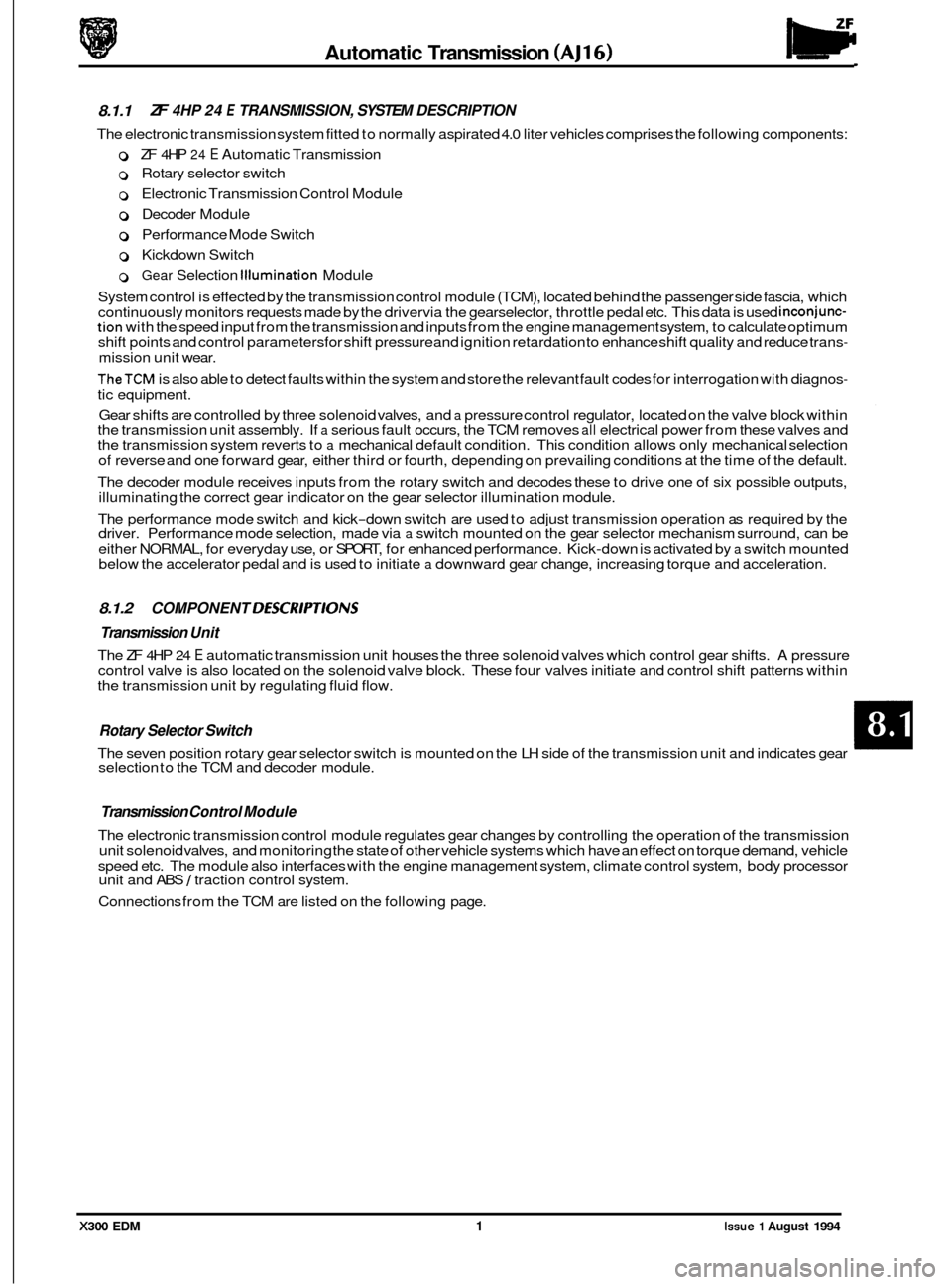
Automatic Transmission (AJ16) w
8.1.1 ZF 4HP 24 E TRANSMISSION, SYSTEM DESCRIPTION
The electronic transmission system fitted to normally aspirated 4.0 liter vehicles comprises the following components:
0 ZF 4HP 24 E Automatic Transmission
0 Rotary selector switch
0 Electronic Transmission Control Module
0 Decoder Module
0 Performance Mode Switch
0 Kickdown Switch
0 Gear Selection Illumination Module
System control is effected by the transmission control module (TCM), located behind the passenger side fascia, which
continuously monitors requests made by the drivervia the gearselector, throttle pedal etc. This data is used
inconiunc- tion with the speed input from the transmission and inputs from the engine management system, to calculate optimum
shift points and control parametersfor shift pressure and ignition retardation to enhance shift quality and reduce trans-
mission unit wear.
TheTCM is also able to detect faults within the system and store the relevant fault codes for interrogation with diagnos-
tic equipment.
Gear shifts are controlled by three solenoid valves, and
a pressure control regulator, located on the valve block within
the transmission unit assembly. If a serious fault occurs, the TCM removes all electrical power from these valves and
the transmission system reverts to a mechanical default condition. This condition allows only mechanical selection
of reverse and one forward gear, either third or fourth, depending on prevailing conditions at the time of the default.
The decoder module receives inputs from the rotary switch and decodes these to drive one of six possible outputs,
illuminating the correct gear indicator on the gear selector illumination module.
The performance mode switch and kick
-down switch are used to adjust transmission operation as required by the
driver. Performance mode selection, made via a switch mounted on the gear selector mechanism surround, can be
either NORMAL, for everyday use, or SPORT, for enhanced performance. Kick
-down is activated by a switch mounted
below the accelerator pedal and is used to initiate a downward gear change, increasing torque and acceleration.
8.1.2 COMPONENT DESCRlPTIONS
Transmission Unit
The ZF 4HP 24 E automatic transmission unit houses the three solenoid valves which control gear shifts. A pressure
control valve is also located on the solenoid valve block. These four valves initiate and control shift patterns within
the transmission unit by regulating fluid flow.
Rotary Selector Switch
The seven position rotary gear selector switch is mounted on the LH side of the transmission unit and indicates gear
selection to the TCM and decoder module.
Transmission Control Module
The electronic transmission control module regulates gear changes by controlling the operation of the transmission
unit solenoid valves, and monitoring the state of other vehicle systems which have an effect on torque demand, vehicle
speed etc. The module also interfaces with the engine management system, climate control system, body processor
unit and ABS
I traction control system.
Connections from the TCM are listed on the following page.
X300 EDM 1 Issue 1 August 1994
Page 8 of 327
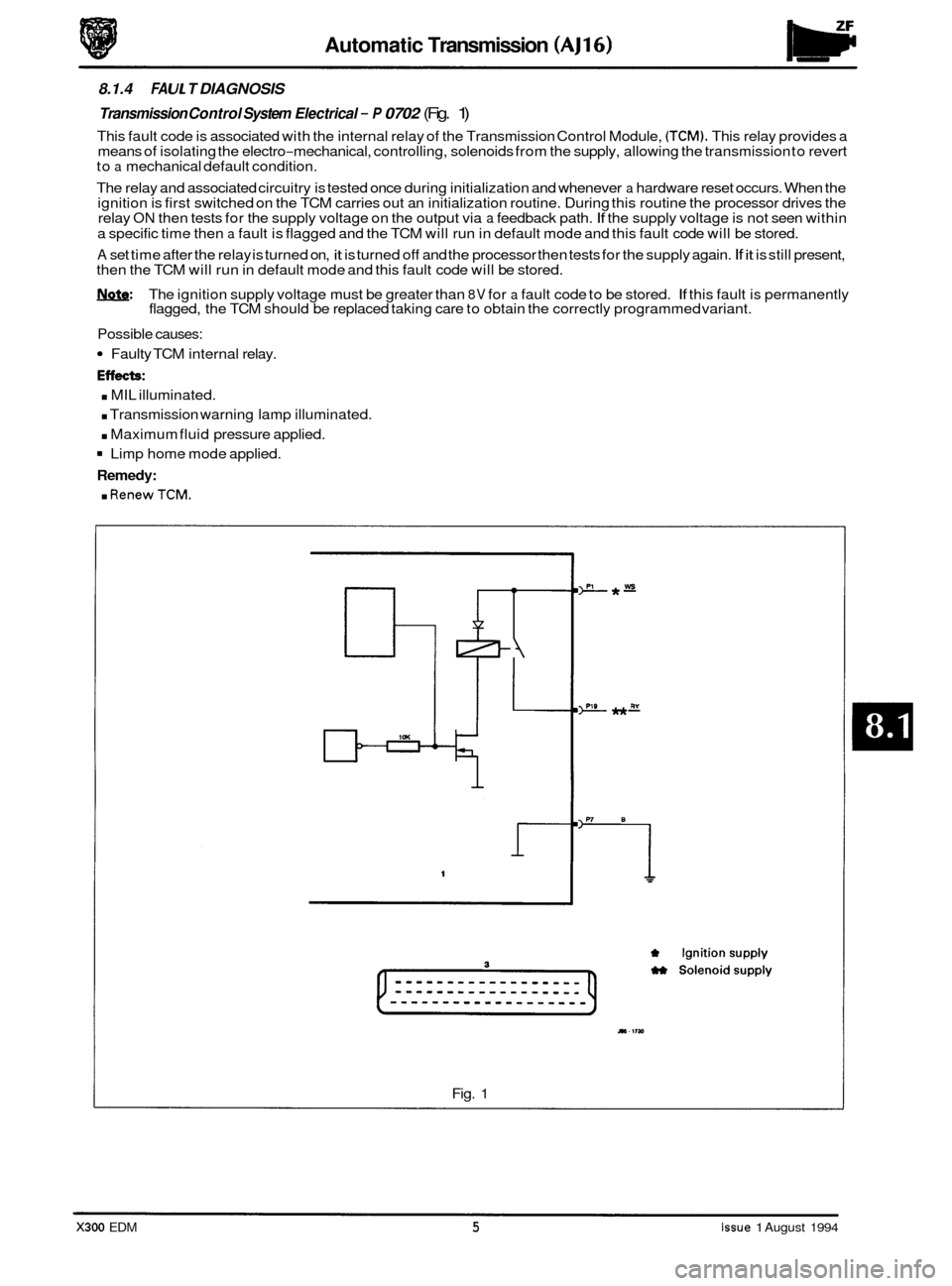
Automatic Transmission (AJ16)
8.1.4 FA U1 T DIAGNOSIS
Transmission Control System Electrical - P 0702 (Fig. 1)
This fault code is associated with the internal relay of the Transmission Control Module, (TCM). This relay provides a
means of isolating the electro-mechanical, controlling, solenoids from the supply, allowing the transmission to revert
to a mechanical default condition.
The relay and associated circuitry is tested once during initialization and whenever
a hardware reset occurs. When the
ignition is first switched on the TCM carries out an initialization routine. During this routine the processor drives the
relay
ON then tests for the supply voltage on the output via a feedback path. If the supply voltage is not seen within
a specific time then
a fault is flagged and the TCM will run in default mode and this fault code will be stored.
A set time after the relay is turned on, it is turned off and the processor then tests for the supply again. If it is still present,
then the TCM will run in default mode and this fault code will be stored.
U: The ignition supply voltage must be greater than 8V for a fault code to be stored. If this fault is permanently
flagged, the TCM should be replaced taking care to obtain the correctly programmed variant.
Possible causes:
Faulty TCM internal relay.
Effects:
. MIL illuminated.
. Transmission warning lamp illuminated.
. Maximum fluid pressure applied.
Limp home mode applied.
. RenewTCM.
Remedy:
Fig. 1
X300 EDM 5 Issue 1 August 1994
Page 19 of 327

Automatic Transmission (AJ16)
TORQUE REDUCTION SIGNAL - P 1780
The diagnostic for this signal is based entirely on feedback from the ECM. If the torque reduction request is active for
greater than 2 seconds, the ECM starts the torque reduction fault timeout (IO seconds). If the signal returns to the
standby condition within this time, the timeout is reset. If the timeout matures then the ECM stores a fault code and
transmits 93% on the torque signal line and also lights the MIL where necessary.
The ECM will also initiate the torque reduction fault timeout
if the signal line is permanently high or low for greater
than 125ms. The conditions for resetting the timeout and the actions if the timeout matures are the same as previously
described above. When the TCM receives the correct indication on the torque signal line, this fault code will be stored
and
a substitute function will be adopted and the warning lamp will be illuminated. The engine management will send
normal torque signal when the torque reduction signal returns to standby or when the ignition is reset.
This torque reduction signal is used during gearshifts to conveythe actual amount of retard to be applied to the ignition
advance angle
afterthe other trims. The signal idles at 17% (or 12% if theTCM wishes to drive the MIL on), and changes
to 20% at the start of a gearshift. This represents 0" retard. When an amount of retard is required, the PWM will increase
to the desired value (between 20% and 90%) and return to 20% and then to idle state at the end of the shift.
TCM
PI HARNESS ECM
CC007/032 P1063/008 P1105/026
TORQUE SIGNAL MALFUNCTION - P 1781
The torque signal is a PWM signal from the ECM to the TCM which conveys information about the actual torque devel- oped by the engine in the range 0 to 510Nm. The base frequency is 91Hz and the signal which is active low should be
within the range 10% to 90% modulation. The torque signal is monitored continuously during initialization and oper
- ation. If the frequency of the signal is incorrect or the signal is out of range, then this fault code will be flagged. The
TCM will adopt a substitute function and the warning lamp will be illuminated. This fault code will only be flagged if the engine speed is above 448 rpm.
TCM
PI HARNESS ECM
CC007/02 1 P1063/007 PI 105/033
Possible causes:
. Faulty harness wiring I connector.
. Faulty signal from ECM.
Effects:
. Transmission warning lamp illuminated.
Substitute torque signal adopted by TCM.
. =Normal mode only available.
. No kickdown facility.
. Maximum fluid pressure applied.
Remedy:
. Repair or renew harness / connector.
Examine ECM fault diagnosis (refer to EDM, section 5.1).
Issue 1 August 1994 16 X300 EDM
Page 26 of 327

Automatic Transmission (AJ16)
SPORT MODE INDICATOR - P 1792
The sport mode lamp is located in the instrument pack. The input is 'pulled up' to nominal battery voltage (+12V) and
is supplied by an ignition switch feed. The TCM drives the signal to ground to turn the lamp on. The diagnostic runs
on the sport mode indicator output continuously during initialization and operation. The
checkcan detect an open cir- cuit, a short circuit to battery and short circuit to ground, although the diagnostic cannot distinguish between an open
circuit and a short to ground.
TCM
(CC007) BULKHEAD HARNESS (FC007) INSTRUMENT PACK (FCOO9)
PIN 49 - SPORT PIN 14
PIN 14
Possible causes:
. Faulty wiring harness I connectors.
. Faulty indicator lamp.
Faulty instrument pack.
Effects:
. No illumination of indicator lamp on instrument pack.
. Permanent illumination of indicator lamp on instrument pack.
Remedy:
. Repair or renew harness 1 wiring.
. Renew indicator lamp.
0 . Examine instrument pack fault diagnosis (refer to EDM, Section 15).
1
Y.IM
Fig. 1 Fault Code PI792 ~~
X300 EDM 23 Issue 1 August 1994
Page 32 of 327
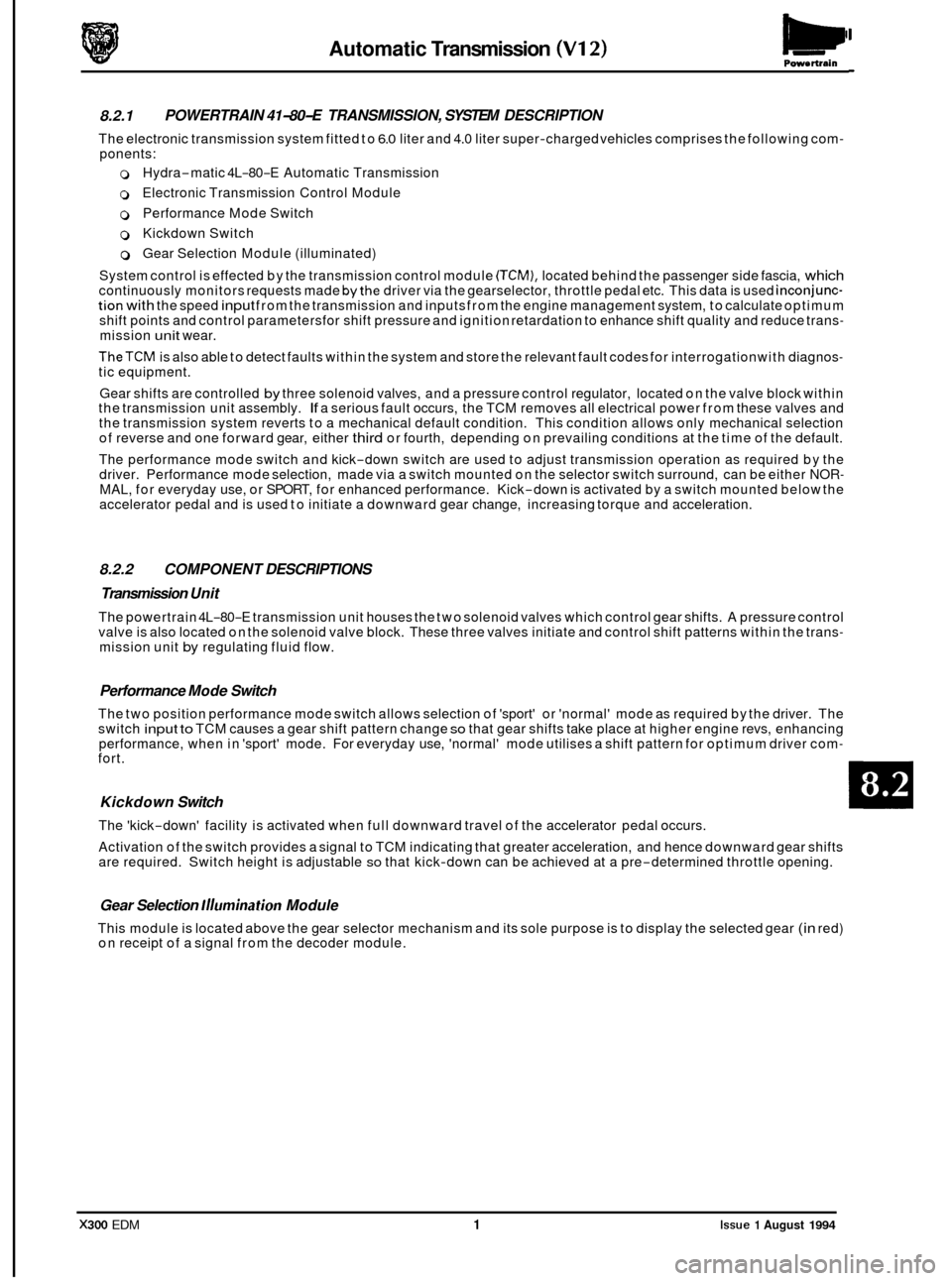
Automatic Transmission (V12) Powertrain
8.2.1 POWERTRAIN
41-80-E TRANSMISSION, SYSTEM DESCRIPTION
The electronic transmission system fitted to 6.0 liter and 4.0 liter super-charged vehicles comprises the following com- ponents:
0 Hydra-matic 4L-80-E Automatic Transmission
0 Electronic Transmission Control Module
0 Performance Mode Switch
0 Kickdown Switch
0 Gear Selection Module (illuminated)
System control is effected by the transmission control module
(TCM), located behind the passenger side fascia, which continuously monitors requests made bythe driver via the gearselector, throttle pedal etc. This data is used inconjunc- tion with the speed input from the transmission and inputs from the engine management system, to calculate optimum
shift points and control parametersfor shift pressure and ignition retardation to enhance shift quality and reduce trans- mission unit wear.
TheTCM is also able to detect faults within the system and store the relevant fault codes for interrogation with diagnos- tic equipment.
Gear shifts are controlled
by three solenoid valves, and a pressure control regulator, located on the valve block within
the transmission unit assembly. If a serious fault occurs, the TCM removes all electrical power from these valves and
the transmission system reverts to a mechanical default condition. This condition allows only mechanical selection
of reverse and one forward gear, either
third or fourth, depending on prevailing conditions at the time of the default.
The performance mode switch and kick
-down switch are used to adjust transmission operation as required by the
driver. Performance mode selection, made via a switch mounted on the selector switch surround, can be either NOR- MAL, for everyday use, or SPORT, for enhanced performance. Kick-down is activated by a switch mounted below the
accelerator pedal and is used to initiate a downward gear change, increasing torque and acceleration.
8.2.2 COMPONENT DESCRIPTIONS
Transmission Unit
The powertrain 4L-80-E transmission unit houses the two solenoid valves which control gear shifts. A pressure control
valve is also located on the solenoid valve block. These three valves initiate and control shift patterns within the trans- mission unit by regulating fluid flow.
Performance Mode Switch
The two position performance mode switch allows selection of 'sport' or 'normal' mode as required by the driver. The
switch input to TCM causes a gear shift pattern change so that gear shifts take place at higher engine revs, enhancing
performance, when in 'sport' mode. For everyday use, 'normal' mode utilises a shift pattern for optimum driver com- fort.
Kickdown Switch
The 'kick-down' facility is activated when full downward travel of the accelerator pedal occurs.
Activation of the switch provides a signal to TCM indicating that greater acceleration, and hence downward gear shifts
are required. Switch height is adjustable
so that kick-down can be achieved at a pre-determined throttle opening.
Gear Selection Illumination Module
This module is located above the gear selector mechanism and its sole purpose is to display the selected gear (in red)
on receipt of a signal from the decoder module.
X300 EDM 1 Issue 1 August 1994
Page 35 of 327

n m 7
W >
S 0 .I v) v) .-
E
2
v) S
I-
U .I c
i!
2
0 c
NR-
ws-
K-
0-
B-
TCM
Pressure switch manifold X 03 Pressure switch manifold Z 04
Performance mode select 05 Calibration select 06
Engine toque reduction 07 Throttle position 11 Engine troque 12 Sensor ground 14 Pressure switch Y 22
Traction control inpuit 23 Kickdown switch 24 Brake switch 25
Transmission temperature 26 Engine speed 30 Vehicle speed output 34 Transmission output speed 36
Transmission input speed 37 Shift solenoid A 39 Transmission malfunction lamp 40 Sport mode lamp 41
Torque converter clutch 42 Shift solenoid B 43 Force motor low 49 Transmission input speed GND 50 .ransmission output spped GND 51 Force motor high 52
55
Vban
53 Vignition
16JDSLIscantool
45 JDS K I scan tool
54 Power ground
I TRANSMISSION Ignition
-OK -OB
-Rw -P - su - GN -Pw - BU -ON - RP - BS - PU - OY - BIN - SB -U -G -OR -s
- GU -ow - OP -0s -N -R
-OB
14/01 Transmission input speed GND
14/02 Transmission input speed
13/01 Transmission output speed GND
13/02 Transmission output speed
1 - 12/10 TCCsolenoid high
- 12/09 TCC solenoid signal
-
-
- -
12/03 Shift solenoid A high
12/01 Shift solenoid A signal
12/03 Shift solenoid B high 12/02 Shift solenoid B signal
-
- 12/13 Force Motor Signal
1211 1 Force motor HI
-
-
-
12/04 Pressure switch manifold X
12/04 Pressure switch manifold Y
12/04 Pressure switch manifold Z
- 12/07 Transmission temperature
- 12/08 Sensor GND
44 Transmission malfunction
14 Sport mode indication
ABS 1 TC CM
03 Traction control signal
iI I
VI2 EMS
II
I -
I - 03 Engine torque
I - 06 torque reduction request
I - 10 Engine speed
I - 07 Vehicle speed
04 throttle position
I
I
I
I - I 04 throttle position
I - 03 Engine torque
I - 06 torque reduction request
I - 10 Engine speed
I - 07 Vehicle speed
I
I
I
I I
I 6 Cyl. GEMS I
I
I
I
1- I
I- 22 Engine speed I
I
,I I
I
I
I - 33 Engine toque
26 Torque reduction request
I - 32 Throttle position
' Performance Mode I
I
000 I
Switch I
I
02 Performance mode select
I
Vban + oq 04 I
r---- 1
I
Brake Switch
I
r---- 1
I
Kickdown Switch
I
Page 37 of 327
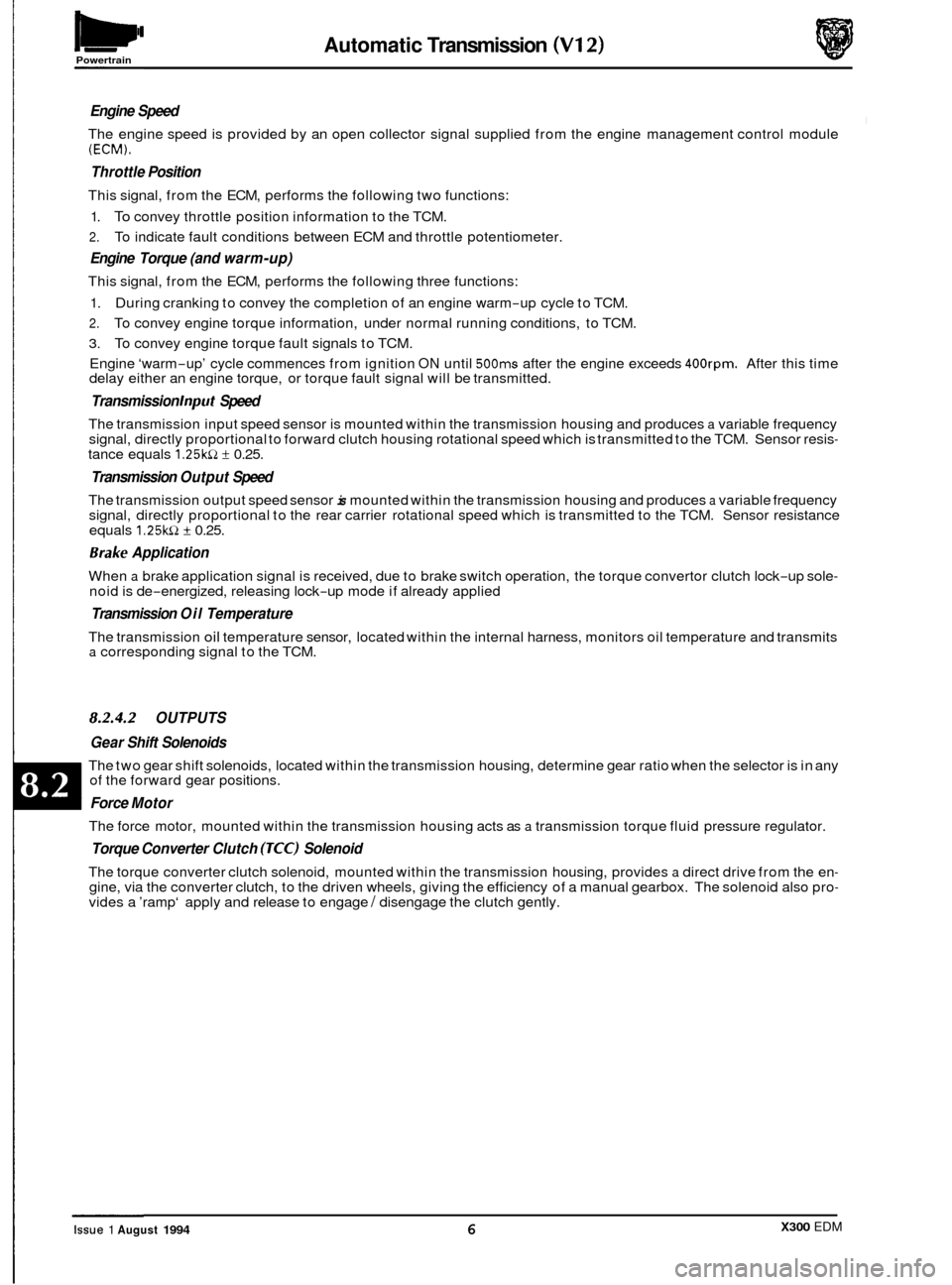
Automatic Transmission (V12) Powertrain
Engine Speed
The engine speed is provided by an open collector signal supplied from the engine management control module
(ECM).
Throttle Position
This signal, from the ECM, performs the following two functions:
1.
2.
Engine Torque (and warm-up)
This signal, from the ECM, performs the following three functions:
1. During cranking to convey the completion of an engine warm
-up cycle to TCM.
2. To convey engine torque information, under normal running conditions, to TCM.
3. To convey engine torque fault signals to TCM.
Engine ‘warm
-up’ cycle commences from ignition ON until 500ms after the engine exceeds 400rpm. After this time
delay either an engine torque, or torque fault signal will be transmitted.
Transmission Input Speed
The transmission input speed sensor is mounted within the transmission housing and produces a variable frequency
signal, directly proportional to forward clutch housing rotational speed which is transmitted to the TCM. Sensor resis- tance equals 1.25kQ f 0.25.
Transmission Output Speed
The transmission output speed sensor is mounted within the transmission housing and produces a variable frequency
signal, directly proportional to the rear carrier rotational speed which is transmitted to the TCM. Sensor resistance
equals
1.25w2 + 0.25.
hake Application
When a brake application signal is received, due to brake switch operation, the torque convertor clutch lock-up sole- noid is de-energized, releasing lock-up mode if already applied
Transmission Oil Temperature
The transmission oil temperature sensor, located within the internal harness, monitors oil temperature and transmits a corresponding signal to the TCM.
To convey throttle position information to the TCM.
To indicate fault conditions between ECM and throttle potentiometer.
8.2.4.2 OUTPUTS
Gear Shift Solenoids
The two gear shift solenoids, located within the transmission housing, determine gear ratio when the selector is in any
of the forward gear positions.
Force Motor
The force motor, mounted within the transmission housing acts as a transmission torque fluid pressure regulator.
Torque Converter Clutch (TCC) Solenoid
The torque converter clutch solenoid, mounted within the transmission housing, provides a direct drive from the en- gine, via the converter clutch, to the driven wheels, giving the efficiency of a manual gearbox. The solenoid also pro- vides a ’ramp‘ apply and release to engage / disengage the clutch gently.
0
0
0
e
X300 EDM Issue 1 August 1994 6
Page 38 of 327

Automatic Transmission (V12) ~ Pow. rtrain
Engine
Torque Reduction and Malfunction Indication
This signal, to the ECM, has three modes of operation.
1. To indicate normal engine operation to the ECM.
2. During gearshifts, to request reduction of engine torque
3. During fault conditions, to inform the ECM.
During normal operation
theTCM outputs a constant duty cycle signal to the ECM. The signal is changed when torque
reduction is required to indicate to the ECM the degree of ignition retardation necessary. If a fault condition, relating
to OBD
II CARB legislation, occurs the TCM will transmit a signal to the ECM relating this event. The ECM will only
respond to this signal if its duration is 100 milli-seconds or longer.
If the signal from the torque reduction line is either HIGH or LOW for 2 or more seconds the EMS will recognise that
a fault may be present and transmit this information to the TCM.
If the signal from the torque reduction line lasts for 2 or more seconds the EMS will return to normal operation.
Sport Mode Indicator Lamp
The sport mode indicator lamp, mounted on the instrument panel, is illuminate when sport mode is selected and the
ignition switch is ON. Sport mode is selected at a two position switch mounted to the rear of the gear selector assembly.
Gearbox Failure Warning Lamp
The gearbox failure warning lamp, mounted on the instrument panel, is illuminated when afault is detected bytheTCM within the transmission electrical or mechanical systems.
Vehicle Speed (12 cylinder vehicles only)
This output signal is calculated from the transmission output speed and supplied to the ECM as an indication of vehicle
speed.
8.2.5 DIAGNOSTIC LINKS
Diagnostic
L line
One of a two wire interface used to activate stored diagnostic codes for reading by external equipment.
Diagnostic K Line
One of a two-wire interface used to communicate stored diagnostic codes for reading by external diagnostic equip- ment.
X300 EDM 7 Issue 1 August 1994
Page 48 of 327
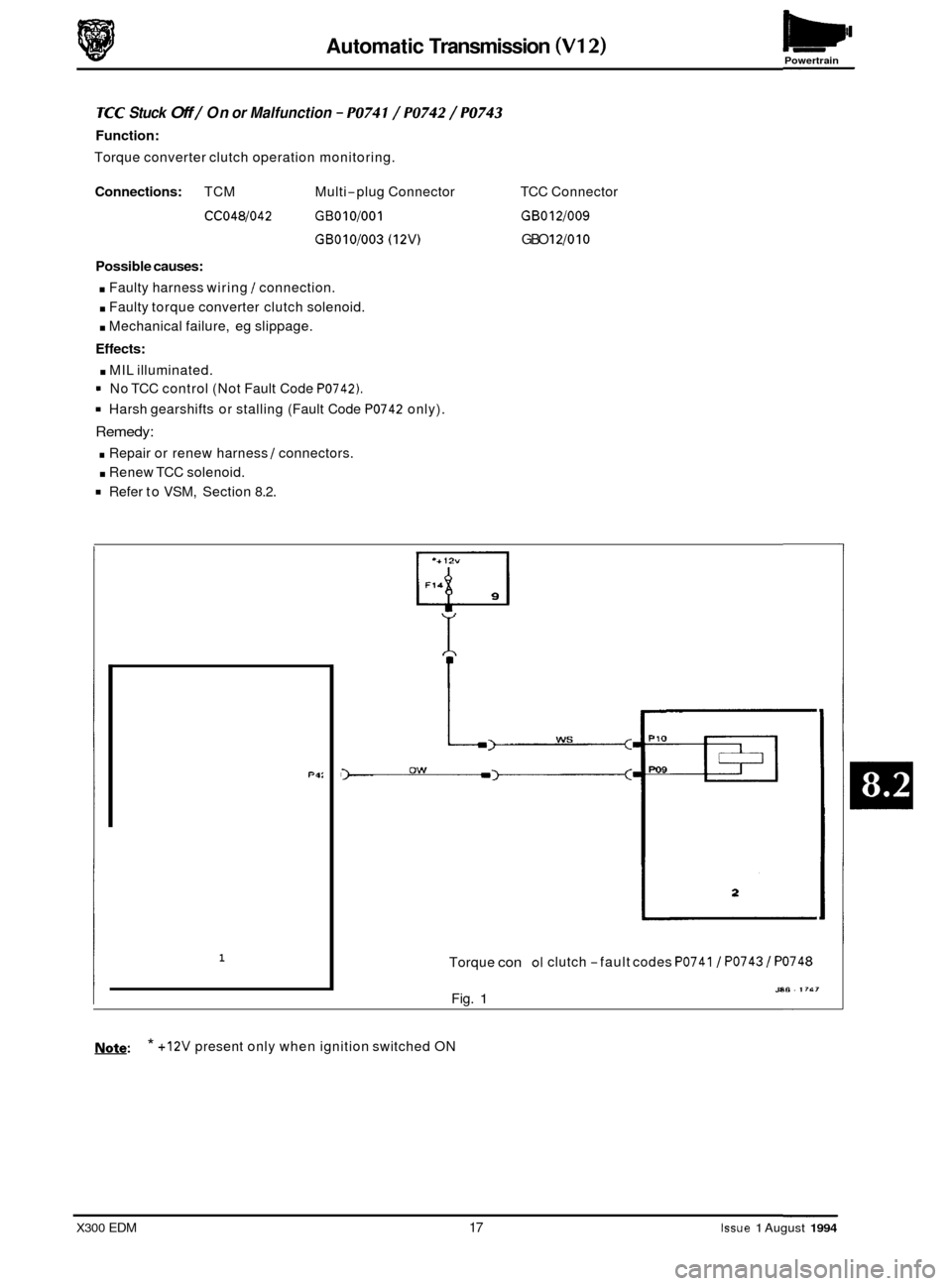
Powertrain Automatic Transmission (V12)
TCC Stuck Off / On or Malfunction - PO74 1 / PO742 / PO743
Function:
Torque converter clutch operation monitoring.
Connections: TCM Multi-plug Connector
CCO48/042 GBOlO/OO1
GB010/003 (12V)
Possible causes:
. Faulty harness wiring 1 connection.
. Faulty torque converter clutch solenoid.
. Mechanical failure, eg slippage.
Effects:
. MIL illuminated.
' No TCC control (Not Fault Code P0742).
Harsh gearshifts or stalling (Fault Code PO742 only).
Remedy:
. Repair or renew harness 1 connectors.
Refer to VSM, Section 8.2.
. Renew TCC solenoid. TCC
Connector
GBOl2/009
GBO 1210 10
PQ:
1 Torque con
Fig. 1
01 clutch -fault codes PO741 1 PO743 I PO748
J80 - IT47
Note: * +12V present only when ignition switched ON
X300 EDM 17 Issue 1 August 1994
Page 50 of 327
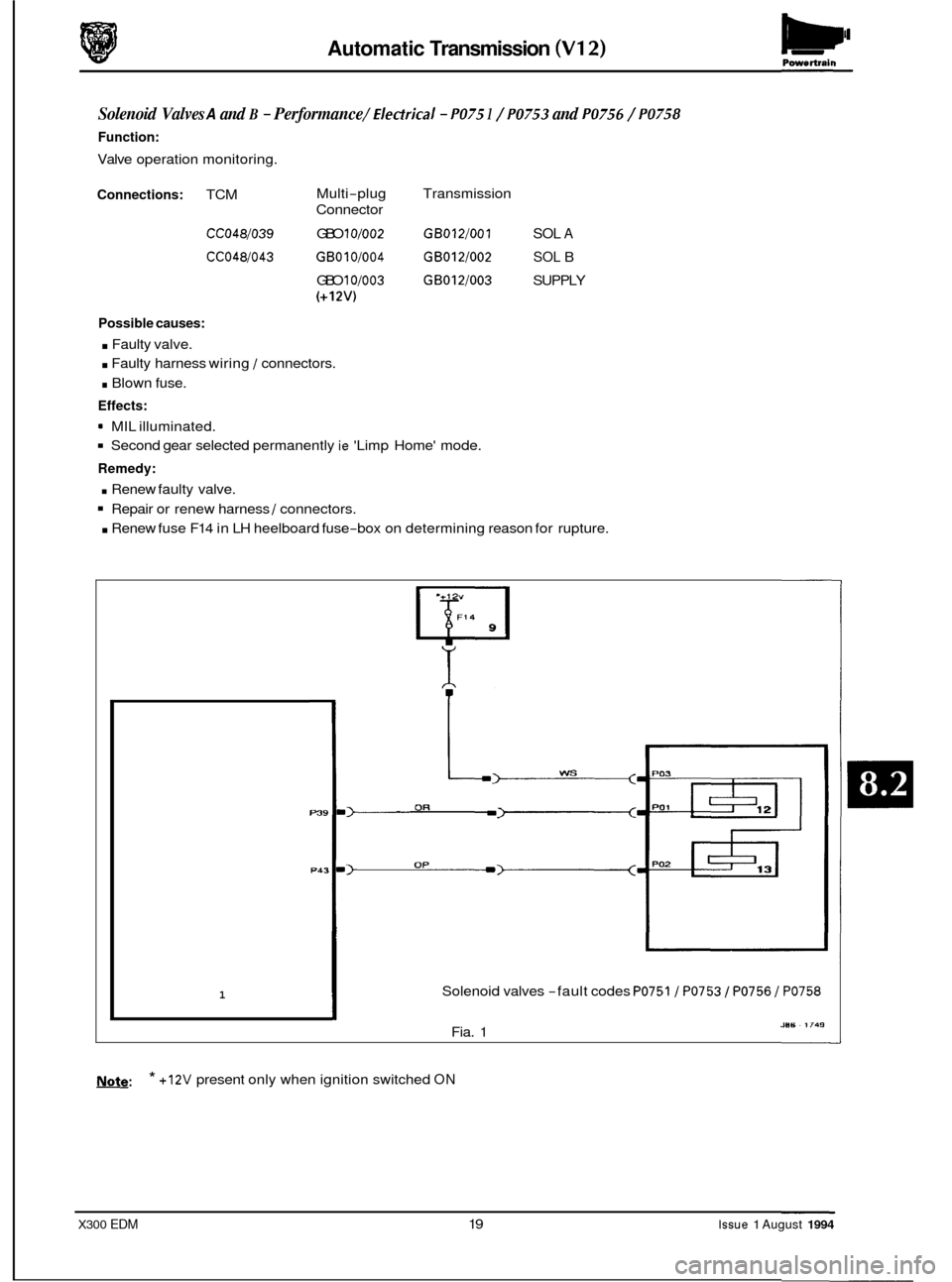
Powertrain Automatic Transmission (V12)
Solenoid Valves A and B - Performance /Electrical - PO75 1 / PO753 and PO756 / PO758
Function:
Valve operation monitoring.
Connections: TCM
CCO48/039
CCO48/043
Multi-plug
Connector
GBO
10/002
GBOl0/004
GBO 10/003
(+12V)
Transmission
GB012/001 SOL A
GBOl2/002 SOL B
GB012/003 SUPPLY
Possible causes:
. Faulty valve.
. Faulty harness wiring 1 connectors.
. Blown fuse.
Effects:
9 MIL illuminated.
Second gear selected permanently ie 'Limp Home' mode.
Remedy:
. Renew faulty valve.
Repair or renew harness 1 connectors.
. Renew fuse F14 in LH heelboard fuse-box on determining reason for rupture.
1 1
Solenoid valves -fault codes PO751 / PO753 / PO756 / PO758
1
Fia. 1 JUl3 ~ 1749
&@: * +12V present
only when ignition switched ON
X300 EDM 19 Issue 1 August 1994